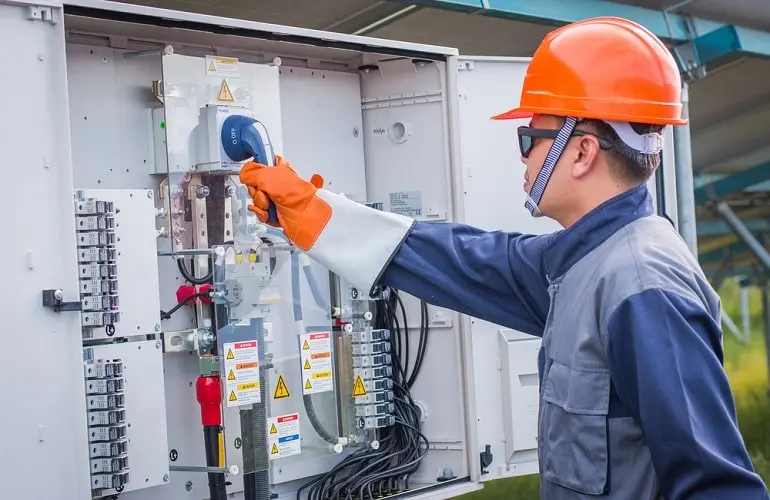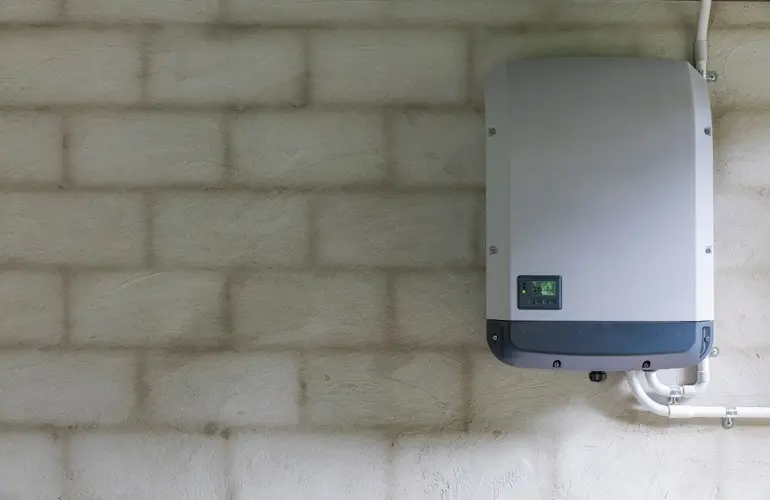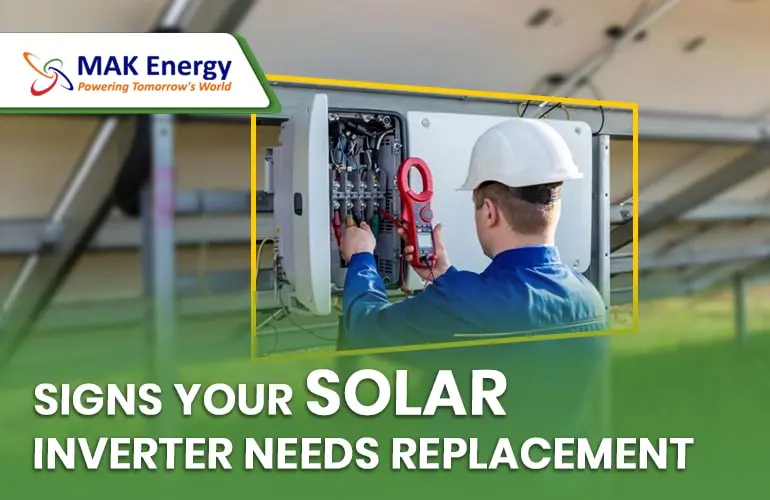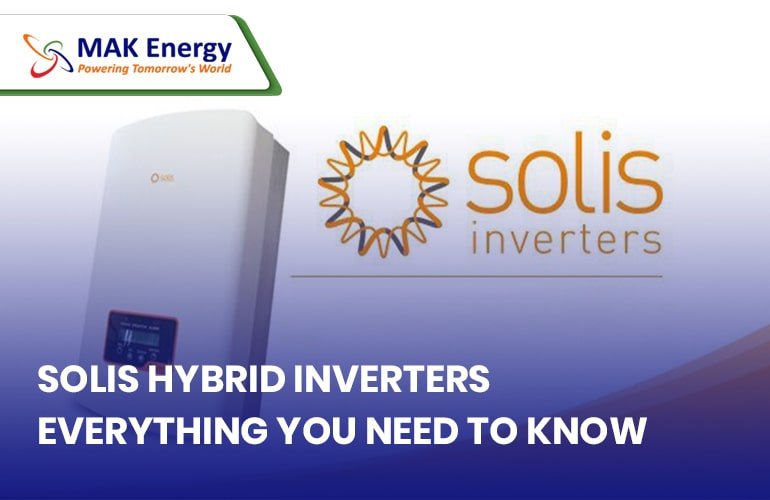The solar inverter is the most critical component of a solar PV system, as it converts the direct current produced by solar panels into usable alternating current for home appliances and businesses. To maximize the efficiency of your PV system, your solar inverter must be working optimally. And If you notice that your solar PV system is generating below-average output, there may be an issue with your solar inverter. But how do you know if your inverter is causing a problem and needs replacement? Here are some signs that indicate the system isn’t functioning properly and should be repaired or replaced as soon as possible.
Experiencing issues with your inverter’s performance? Let MAK Energy be your solution. Get a free quotation for solar panel inverter replacement costs UK today, and ensure you’re maximizing the potential of your solar system.
What are Grid Fault Inverters?
The term grid fault inverter refers to a grid-tied inverter that has encountered an issue preventing it from properly communicating with the power grid. This could be due to various factors such as a faulty communication cable, a damaged inverter, or a problem with the grid itself. A grid-tied inverter, also known as a grid-interactive inverter, is a crucial component in grid-connected solar systems. It converts the direct current (DC) produced by solar panels into alternating current (AC) that matches the voltage, frequency, and phase of the grid, allowing the energy to be used and shared with the power grid. When a grid fault occurs, it can disrupt this process, potentially leading to a shutdown of the inverter to prevent unsafe conditions or damage.
How can I determine if my solar inverter is faulty?
If you’re concerned that your solar inverter may be malfunctioning, these are several steps you can take to assess your solar inverter condition. Timely maintenance and monitoring are key to ensuring that your solar inverter operates at peak efficiency and continues to contribute to your sustainable energy goals. Remember, addressing issues early can help prevent a decrease in solar energy production and maintain the longevity of your system.

Decreased Energy Production
One of the major signs that your inverter isn’t performing up to par is a decrease in energy production. A faulty solar inverter often begins to drop energy production over time. If you’re experiencing a decline in solar PV system production, there’s a possibility that the solar inverter is faulty and may need replacement. To investigate further, reach out to a professional MCS-certified installer to determine the cause of the decrease.
Warning Lights
The second most common sign is an error message on the display screen or warning lights flashing or blinking repeatedly. These indicators are also considered early signs of a solar inverter fault. As soon as you notice such warning lights or error messages, simply contact our team. A timely response can prevent you from solar inverter replacement.
Strange Noises
The solar inverter is comprised of various micro components, and if there is an issue with any of its internal parts, it may produce strange noises that need to be addressed promptly. If these noises persist over time, it’s a clear indication that the solar inverter replacement is required.
Age of the Inverter
As with all electronic devices, inverters have a limited lifespan. If your inverter is older and nearing the end of its lifespan, it may start generating issues. Old inverters are more prone to failure and can result in decreased energy production. Therefore, it’s crucial to consider replacement to ensure optimal performance and efficiency for your solar system.
Frequent Tripping
Another sign that is alarming for your inverter health is the frequent tripping of your circuit breaker. Although, there might be multiple reasons behind tripping, but in most case the potential cause should be a malfunction solar inverter. And if you face such frequent tripping in your bracket, consult with the professional installer to diagnose the actual reason behind the frequent tripping of your electricity circuit.
Overheating
Regularly monitor the surface temperature of your solar inverter by gently touching its casing. Detecting any signs of overheating is crucial as it can cause performance degradation and potentially irreversible damage to the inverter. Keep a vigilant eye on temperature fluctuations to ensure optimal functioning and longevity of your solar power system.
Fluctuating output
Have you observed irregularities in your energy output? Variations in energy generation, particularly when weather conditions remain consistent, may indicate an underlying issue with your inverter. It’s essential to address such fluctuations promptly to ensure the continued efficiency and reliability of your solar power system.
How to Replace a Solar Inverter?
Replacing a solar inverter is a technical process that must be handled by professionals. Here are the steps involved in solar inverter replacement.
To replace a solar inverter, first power down the system and disconnect the old inverter. Remove it, then install the new one, ensuring it’s secure and properly oriented. Reconnect the wires, power on, and test for errors. Always prioritize safety; if unsure, seek a professional’s help. This is a general guide—consult the manufacturer’s manual or a technician for specifics.

Conclusion
Dealing with any malfunction in your solar PV system can be a source of significant frustration, but issues with your solar inverter are particularly vexing and can lead to substantial expenses. To avoid the hefty costs associated with replacing or repairing your inverter, it’s crucial to recognize the signs of a faulty unit. Start by monitoring your energy production for any declines, check for any error messages on the display, and be aware of frequent tripping or unusual noises emanating from the inverter. Consulting with a professional can provide clarity and direction. Regular checks on your inverter’s health and diligent maintenance are essential strategies to prevent the need for costly replacements and ensure the enduring efficiency of your solar energy system.
Take charge of your solar energy system’s health—schedule a professional inspection today and ensure peak performance for years to come!
FAQs
Why is my electricity bill higher even though I have a solar system?
A sudden increase in your bill despite having solar PV system installer on your space could be a sign that your inverter is not operating efficiently and may need a replacement.
Can a solar inverter stop working before its expected lifespan?
Yes, there are possibilities that the solar inverter may stop working before reaching its expected lifespan, requiring replacement.
What should I do if I see an error message on my solar inverter’s screen?
An error message is a clear indication of a problem. Contact a certified solar technician to diagnose and resolve the issue.
Is it better to repair or replace a faulty solar inverter?
This depends on the severity of the issue, the cost of repairs, and the age of your inverter. A professional assessment can help you decide.



